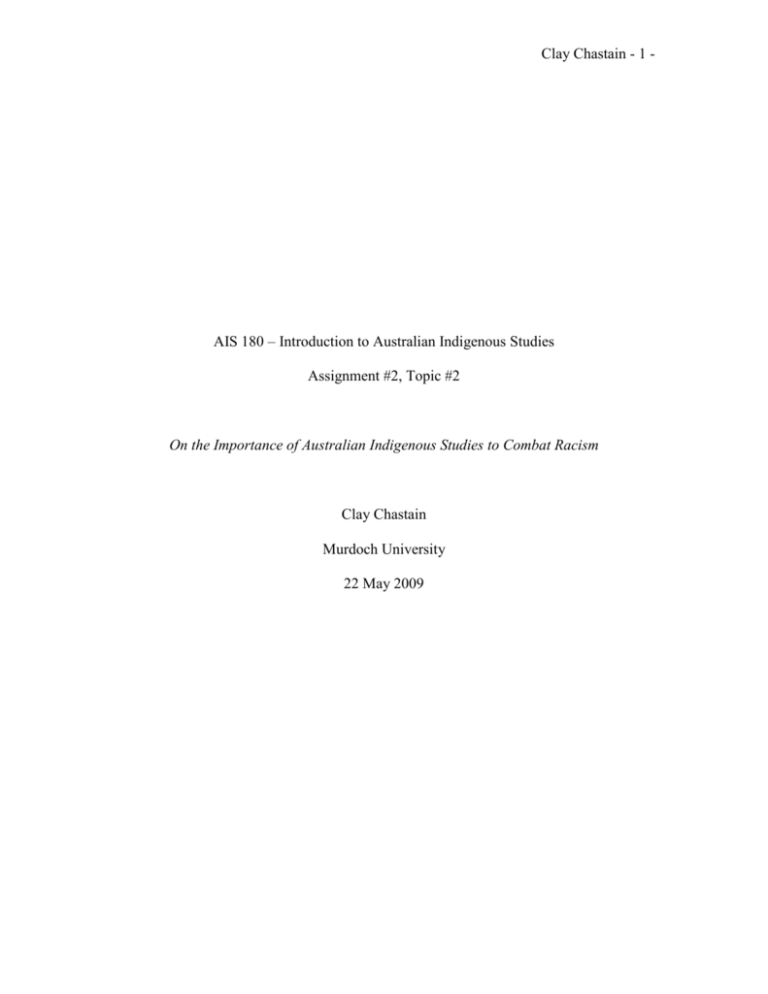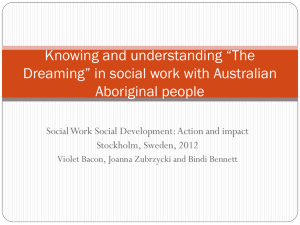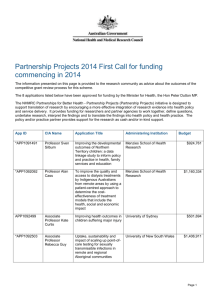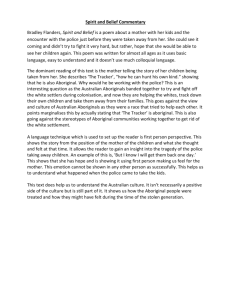Essay (Importance of Aboriginal Studies)
advertisement

Clay Chastain - 1 - AIS 180 – Introduction to Australian Indigenous Studies Assignment #2, Topic #2 On the Importance of Australian Indigenous Studies to Combat Racism Clay Chastain Murdoch University 22 May 2009 Clay Chastain - 2 In the context of Australian Aboriginal studies, the importance of historic, cultural, and political investigation in schools is often over-generalized, marginalized, or completely overlooked for non-Aboriginal and Aboriginal students alike. Because of the historically Westernized viewpoint, education on Aboriginal topics has been sparse and inaccurate, spreading long-standing racist ideologies and reinforcing negative cultural connotations instead of explaining the actuality of the Aboriginal people. Throughout this paper, examples will be given of these oversights in the educational system and provide details into the realities of the Aboriginal context in Australia, as well as positioning the idea of progressive education and the importance of a full study of indigenous materials. The end goal of the paper is to stress the overall importance of teaching accurate Aboriginal history and culture in a more applicable and appropriate way in order to overcome negative perpetuated cultural stereotypes through the use of academic insights. While the subject of race and racism is decisively a touchy subject even among academia, the factual accounts of younger Australian students in an anthropological study have produced empirical data on the nature of the foundation of their beliefs towards Aboriginals. Although the idea of racism is perceived as being a negative quality, many of the students inadvertently admitted a level of socialization towards Aboriginals that reflected a significant degree of counterfactual racial motivations. In this study, produced by Nado Aveling in 1998, the author tries to introduce the concepts of racism in terms of the Western identity, as well as providing the compelling racial data. One of the founding problems that the author mentions is the way that Australian school children are being educated in terms of Aboriginal studies, stating that Clay Chastain - 3 “. . . generations of schoolchildren learned that Captain Cook ‘discovered’ Australia, . . . a vast land, sparsely populated by ‘spear-carrying and witchetty-grub-eating primitives’” (Jones, 1998, p. 15). Aveling notes that only recently in 1992 was the notion of Terra Nullis¸ or the idea that Australia was “empty land” before Western colonization, finally dispelled by a controversial High Court decision (Jones, 1998, p. 16). Although the Westernized story of Captain Cook’s discovery of a barely inhabited land is an example that Aveling cites came from textbooks in the 1960’s and 1970’s, the educational inaccuracies are still perpetuated by others in academia and government offices. For example, in 1988, the former Minster of Territories, Paul Hasluck, states that: “There was nothing that could be recognized as a homogeneous and integrated aboriginal society. Here and there throughout the continent there were crumbling groups of aboriginal people bound together by ancient tradition and kinship and living under a fading discipline. . . None of these groups could be identified as a society in the same way as the rest of the people in Australia could be identified as a society” (Hasluck, 1988). Clearly, in this instance, the inaccuracies of Aboriginal society should be obvious; the idea that Aboriginals do not have a comparable society to Australians seems unlikely. According to a 2009 dictionary, a society is “an organized group of persons associated together for religious, benevolent, cultural, scientific, political, patriotic, or other purposes” (Dictionary.com, 2009), which indicates that Aboriginals, like Australians, have a consistent society. As well, upon the actual study of Aboriginals, the idea of Clay Chastain - 4 kinship and the deep cultural heritage passed down through generations contradicts the notion of Aboriginal people society being heterogeneous or disintegrated. In light of remarks like Hasluck’s, and the data presented by Aveling, it seems that there is a long tradition of socialization through education that incorrectly casts Aboriginals in a negative light; this, coupled with the poor overall perspective on Aboriginal culture through the secondary school system, has led children to develop a distinctively Westernized, and often racist, view towards Aboriginals. In 2006 study on the racism of the white population in the Northern Territory, the author cites a study that found that “. . . racism is structurally embedded in society and is reflected in normal discourse” (Kessaris, 2006). The author’s argument is that because of the poor educational practices in the past, and the years of cultural exploitation, the white population has become accepting of racism and practices it towards the indigenous population through a normalized perspective. The author asserts that “[t]he normalized nature of racism means that large numbers, in fact the majority, of nice, decent, regular Mununga [white] people, can and do, routinely participate in everyday kinds of casual racism so ordinary that they do not even recognize it.” (Kessaris, 2006) With this said, the problem of Aboriginal education does not solely rely upon the issue of racism, but rather is a factor in the situation. Because of the overall nature of the Australian education system, it is not just the non-Aboriginals who are being inaccurately socialized, but also the Aboriginals. Many recent articles (as of May 2009) in major Australian publications highlight these problems. One of these articles cite curriculum which does not even teach “. . . history, geography, nor [sic] science” in more remote areas of Australia (Ferrari, 2008). In other cases, Aboriginal children leave their Clay Chastain - 5 schooling unable to even read at level of competency (Slattery, 2008). Largely, it can be said that these situations influence the lack of cultural understanding by both nonAboriginals and Aboriginal students alike. The largest obstacle to overcome, however, remains elusive. While the solution seems to be an easy one, the lack of proper education in Australia towards Aboriginals and their culture for such an extended period of time has created a socially acceptable form of racism. Because of this, applying the basic idea of increasing educational funding is a limited approach at best. Without conclusive studies on these subjects, the most critical aspect of defeating racism and supporting Aboriginal culture via updated schooling initiative is under-documented and more difficult to study. One of the studies that does exist follows an educational program designed to promote cultural understanding for Australian Aboriginals from a white perspective in the workplace actually found that after three months “there was no significant difference to baseline levels of prejudice and stereotyping”. Even though a person has knowledge, it does not inherently mean that racism will be impacted in any meaningful way. While the study did note that it decreased what it describes as “old-fashioned” racism, the conclusion of the study was that “further research must be done to develop more successful strategies of prejudice reduction and stereotype change that are also applicable to 'real world' contexts”. Essentially, this study is one of the few studies that does not just report that there is racism and that more education is essential, it also follows through a full study on actual cultural changes over time. However, while these types of studies are essential, along with the more personal embedding of Aveling into young school children’s socialization, they clearly present a Clay Chastain - 6 deeper problem in combating the problem. There is, at this time, a distinct lack of conclusive studies that deal with Australian Aboriginals and what methods are the best approaches to improving the education of both Aboriginals and non-Aboriginals. While similar studies exist for almost any marginalized population, especially those of indigenous populations, the context of Australia is unique to itself and more work needs to be done to produce progressive results in general education. In conclusion, the end result of this information is that education and research into Aboriginal culture is a huge portion of the battle against the traditional Westernized viewpoint. It is crucial for everyone to attempt to have a firm understanding of the indigenous culture of Australia. Not only is it the underlying culture of the first inhabitants of the land, but it is a necessary knowledge for everyday relations with a significant portion of current Australians. By increasing general knowledge of Aboriginal culture, more studies and attempts at combating negative stereotypes will likely be investigated, as well as the natural process of spreading progressive ideologies to anyone who is in the country. Word Count: 1,573 Clay Chastain - 7 Works Cited Ferrari, J. `Education Apartheid' Failing Aboriginal Kids. Australian, The. 5 Apr. 2008. Hasluck, P. 1988. Shades of Darkness: Aboriginal Affairs, 1925-1965. Melbourne: Melbourne University Press. Hill, M. E., & Augoustinos, M. (2001). Stereotype Change and Prejudice Reduction: Short- and Long-term Evaluation of a Cross–cultural Awareness Programme. Journal of Community & Applied Social Psychology, 11(4), 243-262. Kessaris, T. N. (2006). About Being Mununga (Whitefulla): Making Covert Group Racism Visible. Journal of Community & Applied Social Psychology, 16(5), 347362. Slattery, L. `Back to basics' key for aboriginal schools – Indigenous Affairs. Australian, The. 11 February 2008. Society. (n.d.). Dictionary.com Unabridged (v 1.1, Based on Random House 2009). Retrieved May 12, 2009, from Dictionary.com website: http://dictionary1.classic.reference.com/browse/society.








